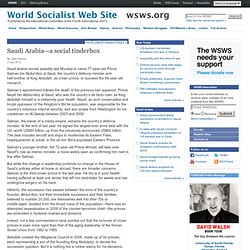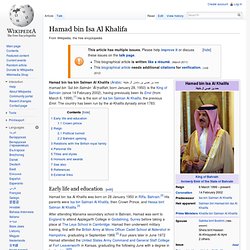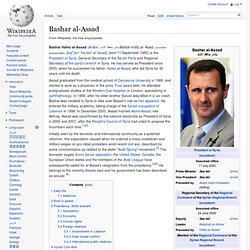

Saudi Arabia—a social tinderbox. By Jean Shaoul 2 July 2012 Saudi Arabia moved speedily last Monday to name 77-year-old Prince Salman bin Abdul-Aziz al-Saud, the country’s defence minister and half-brother of King Abdullah, as crown prince, to succeed the 89-year-old monarch.

Salman’s appointment follows the death of the previous heir apparent, Prince Nayef bin Albdul-Aziz al-Saud, who was the country’s de facto ruler, as King Abdullah himself is in extremely poor health. Nayef, an arch conservative and brutal oppressor of the Kingdom’s Shi’ite population, was responsible for the country’s notorious internal security, and won praise from Washington for his crackdown on Al Qaeda between 2003 and 2006. Salman, the owner of a media empire, remains the country’s defence minister. At the end of last year, he signed the largest-ever arms deal with the US, worth US$90 billion, up from the previously announced US$60 billion. Few apart from the ruling clique have derived much benefit from its oil wealth. Hamad bin Isa Al Khalifa. Hamad bin Isa bin Salman Al Khalifa (Arabic: حمد بن عيسى بن سلمان آل خليفة Ḥamad bin ʿĪsā bin Salmān ʾĀl Ḫalīfah; born January 28, 1950) is the King of Bahrain (since 14 February 2002), having previously been its Emir (from March 6, 1999).[1] He is the son of Isa bin Salman Al Khalifa, the previous Emir.

The country has been run by the al-Khalifa dynasty since 1783. Early life and education[edit] Hamad bin Isa Al Khalifa was born on 28 January 1950 in Riffa, Bahrain.[2] His parents were Isa bin Salman Al Khalifa, then Crown Prince, and Hessa bint Salman Al Khalifa.[3] After attending Manama secondary school in Bahrain, Hamad was sent to England to attend Applegarth College in Godalming, Surrey before taking a place at The Leys School in Cambridge. Crown prince[edit] Hamad was designated as heir apparent by his father on 27 June 1964. In October 1977, Hamad started learning to fly helicopters, successfully completing the training in January 1978. Reign[edit] President - Bashar al-Assad. Assad graduated from the medical school of Damascus University in 1988, and started to work as a physician in the army.

Four years later, he attended postgraduate studies at the Western Eye Hospital, in London, specializing in ophthalmology. In 1994, after his elder brother Bassel was killed in a car crash, Bashar was recalled to Syria to take over Bassel's role as heir apparent. He entered the military academy, taking charge of the Syrian occupation of Lebanon in 1998. In December 2000, Assad married Asma Assad, née Akhras. Assad was reconfirmed by the national electorate as President of Syria in 2000 and 2007, after the People's Council of Syria had voted to propose the incumbent each time.[1][2] Initially seen by the domestic and international community as a potential reformer, this expectation ceased when he ordered a mass crackdown and military sieges on pro-rebel protesters amid recent civil war, described by some commentators as related to the wider "Arab Spring" movement.
Understanding the History of Israel Part 1. My Iranian Road Trip.